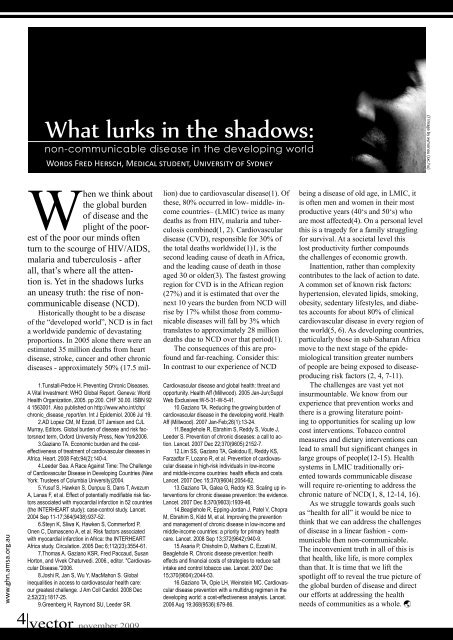You also want an ePaper? Increase the reach of your titles
YUMPU automatically turns print PDFs into web optimized ePapers that Google loves.
What lurks in the shadows:<br />
non-communicable disease in the developing world<br />
Words Fred Hersch, Medical student, University of Sydney<br />
// Image by xymonau (sxc.hu)<br />
www.ghn.amsa.org.au<br />
1.Tunstall-Pedoe H. Preventing Chronic Diseases.<br />
A Vital Investment: WHO Global Report. Geneva: World<br />
Health Organization, 2005. pp 200. CHF 30.00. ISBN 92<br />
4 1563001. Also published on http://www.who.int/chp/<br />
chronic_disease_report/en. Int J Epidemiol. 2006 Jul 19.<br />
2.AD Lopez CM, M Ezzati, DT Jamison and CJL<br />
Murray, Editors. Global burden of disease and risk factorsnext<br />
term, Oxford University Press, New York2006.<br />
3.Gaziano TA. Economic burden and the costeffectiveness<br />
of treatment of cardiovascular diseases in<br />
Africa. Heart. 2008 Feb;94(2):140-4.<br />
4.Leeder Sea. A Race Against Time: The Challenge<br />
of Cardiovascular Disease in Developing Countries (New<br />
York: Trustees of Columbia University)2004.<br />
5.Yusuf S, Hawken S, Ounpuu S, Dans T, Avezum<br />
A, Lanas F, et al. Effect of potentially modifiable risk factors<br />
associated with myocardial infarction in 52 countries<br />
(the INTERHEART study): case-control study. Lancet.<br />
2004 Sep 11-17;364(9438):937-52.<br />
6.Steyn K, Sliwa K, Hawken S, Commerford P,<br />
Onen C, Damasceno A, et al. Risk factors associated<br />
with myocardial infarction in Africa: the INTERHEART<br />
Africa study. Circulation. 2005 Dec 6;112(23):3554-61.<br />
7.Thomas A. Gaziano KSR, Fred Paccaud, Susan<br />
Horton, and Vivek Chaturvedi. 2006., editor. "Cardiovascular<br />
Disease."2006.<br />
8.Joshi R, Jan S, Wu Y, MacMahon S. Global<br />
inequalities in access to cardiovascular health care:<br />
our greatest challenge. J Am Coll Cardiol. 2008 Dec<br />
2;52(23):1817-25.<br />
9.Greenberg H, Raymond SU, Leeder SR.<br />
When we think about<br />
the global burden<br />
of disease and the<br />
plight of the poorest<br />
of the poor our minds often<br />
turn to the scourge of HIV/AIDS,<br />
malaria and tuberculosis - after<br />
all, that’s where all the attention<br />
is. Yet in the shadows lurks<br />
an uneasy truth: the rise of noncommunicable<br />
disease (NCD).<br />
Historically thought to be a disease<br />
of the “developed world”, NCD is in fact<br />
a worldwide pandemic of devastating<br />
proportions. In 2005 alone there were an<br />
estimated 35 million deaths from heart<br />
disease, stroke, cancer and other chronic<br />
diseases - approximately 50% (17.5 million)<br />
due to cardiovascular disease(1). Of<br />
these, 80% occurred in low- middle- income<br />
countries– (LMIC) twice as many<br />
deaths as from HIV, malaria and tuberculosis<br />
combined(1, 2). Cardiovascular<br />
disease (CVD), responsible for 30% of<br />
the total deaths worldwide(1)1, is the<br />
second leading cause of death in Africa,<br />
and the leading cause of death in those<br />
aged 30 or older(3). The fastest growing<br />
region for CVD is in the African region<br />
(27%) and it is estimated that over the<br />
next <strong>10</strong> years the burden from NCD will<br />
rise by 17% whilst those from communicable<br />
diseases will fall by 3% which<br />
translates to approximately 28 million<br />
deaths due to NCD over that period(1).<br />
The consequences of this are profound<br />
and far-reaching. Consider this:<br />
In contrast to our experience of NCD<br />
Cardiovascular disease and global health: threat and<br />
opportunity. Health Aff (Millwood). 2005 Jan-Jun;Suppl<br />
Web Exclusives:W-5-31-W-5-41.<br />
<strong>10</strong>.Gaziano TA. Reducing the growing burden of<br />
cardiovascular disease in the developing world. Health<br />
Aff (Millwood). 2007 Jan-Feb;26(1):13-24.<br />
11.Beaglehole R, Ebrahim S, Reddy S, Voute J,<br />
Leeder S. Prevention of chronic diseases: a call to action.<br />
Lancet. 2007 Dec 22;370(9605):2152-7.<br />
12.Lim SS, Gaziano TA, Gakidou E, Reddy KS,<br />
Farzadfar F, Lozano R, et al. Prevention of cardiovascular<br />
disease in high-risk individuals in low-income<br />
and middle-income countries: health effects and costs.<br />
Lancet. 2007 Dec 15;370(9604):2054-62.<br />
13.Gaziano TA, Galea G, Reddy KS. Scaling up interventions<br />
for chronic disease prevention: the evidence.<br />
Lancet. 2007 Dec 8;370(9603):1939-46.<br />
14.Beaglehole R, Epping-Jordan J, Patel V, Chopra<br />
M, Ebrahim S, Kidd M, et al. Improving the prevention<br />
and management of chronic disease in low-income and<br />
middle-income countries: a priority for primary health<br />
care. Lancet. 2008 Sep 13;372(9642):940-9.<br />
15.Asaria P, Chisholm D, Mathers C, Ezzati M,<br />
Beaglehole R. Chronic disease prevention: health<br />
effects and financial costs of strategies to reduce salt<br />
intake and control tobacco use. Lancet. 2007 Dec<br />
15;370(9604):2044-53.<br />
16.Gaziano TA, Opie LH, Weinstein MC. Cardiovascular<br />
disease prevention with a multidrug regimen in the<br />
developing world: a cost-effectiveness analysis. Lancet.<br />
2006 Aug 19;368(9536):679-86.<br />
being a disease of old age, in LMIC, it<br />
is often men and women in their most<br />
productive years (40‘s and 50‘s) who<br />
are most affected(4). On a personal level<br />
this is a tragedy for a family struggling<br />
for survival. At a societal level this<br />
lost productivity further compounds<br />
the challenges of economic growth.<br />
Inattention, rather than complexity<br />
contributes to the lack of action to date.<br />
A common set of known risk factors:<br />
hypertension, elevated lipids, smoking,<br />
obesity, sedentary lifestyles, and diabetes<br />
accounts for about 80% of clinical<br />
cardiovascular disease in every region of<br />
the world(5, 6). As developing countries,<br />
particularly those in sub-Saharan Africa<br />
move to the next stage of the epidemiological<br />
transition greater numbers<br />
of people are being exposed to diseaseproducing<br />
risk factors (2, 4, 7-11).<br />
The challenges are vast yet not<br />
insurmountable. We know from our<br />
experience that prevention works and<br />
there is a growing literature pointing<br />
to opportunities for scaling up low<br />
cost interventions. Tobacco control<br />
measures and dietary interventions can<br />
lead to small but significant changes in<br />
large groups of people(12-15). Health<br />
systems in LMIC traditionally oriented<br />
towards communicable disease<br />
will require re-orienting to address the<br />
chronic nature of NCD(1, 8, 12-14, 16).<br />
As we struggle towards goals such<br />
as “health for all” it would be nice to<br />
think that we can address the challenges<br />
of disease in a linear fashion - communicable<br />
then non-communicable.<br />
The inconvenient truth in all of this is<br />
that health, like life, is more complex<br />
than that. It is time that we lift the<br />
spotlight off to reveal the true picture of<br />
the global burden of disease and direct<br />
our efforts at addressing the health<br />
needs of communities as a whole. <br />
4 vector november <strong>2009</strong>
















